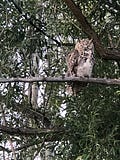This year has been the year of the owl for me. It started last spring when I noticed a large owl often perched in two or three specific trees along a trail that I usually walk. One day, tucked high in the hollow of a dead tree, I saw what I thought was a small set of owl eyes. Daily for several months, I would stop to greet the ba…
Keep reading with a 7-day free trial
Subscribe to Smaller & Deeper to keep reading this post and get 7 days of free access to the full post archives.




